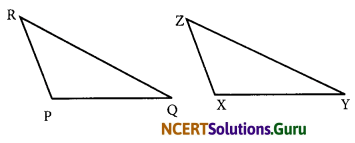These NCERT Solutions for Class 7 Maths Chapter 7 Congruence of Triangles Ex 7.2 Questions and Answers are prepared by our highly skilled subject experts.
NCERT Solutions for Class 7 Maths Chapter 7 Congruence of Triangles Exercise 7.2
Question 1.
Which congruence criterion do you use in the following?
(a) Given : AC = DF
AB = DE
BC = EF
So, ΔABC ≅ ΔDEF

(b) Given : ZX = RP
RQ = ZY
∠PRQ = ∠XZY
So, ΔPQR ≅ ΔXYZ

(c) Given:
∠MLN = ∠FGH
∠NML = ∠GFH
ML = FG
So, ΔLMN ≅ ΔGFH

(d) Given : EB = DB
∠A = ∠C = 90°
AE = BC
So, ΔABE ≅ ΔCDB

Answer:
(a) Given: AC = DF
AB = DE
BC = EF
So, ΔABC ≅ ΔDEF
By SSS Congruence Criterion
(b) Given: ZX = RP
RQ = ZY
∠PRQ = ∠XZY
So, ΔPQR ≅ ΔXYZ
By SAS Congruence Criterion
(c) Given:
∠MLN = ∠FGH
∠NML = ∠GFH
ML = FG
ΔLMN ≅ ΔGFH
By ASA Congruence Criterion
(d) Given: EB = DB
AE = BC
∠A = ∠C = 90°
So, ΔABE ≅ ΔCDB
By RHS Congruence Criterion.
![]()
Question 2.
You want to show that ΔART ≅ ΔPEN,
(a) If you have to use SSS criterion, then you need to show

(i) AR =
(ii) RT =
(iii) AT =
(b) If it is given that ∠T = ∠N and you are to use SAS criterion, you need to have
(i) RT = and
(ii) PN =
(c) If it is given that AT = PN and you are to use ASA criterion, you need to have
(i) ∠RAT =
(ii) ∠ATR =
Answer:
ΔART ≅ ΔPEN
(a) (i) AR = PE
(ii) RT = EN
(iii) AT = PN
(b) Given: ∠T = ∠N
(i) RT = EN
(ii) PN = AT
(c) (i) ∠RAT = ∠EPN
(ii) ∠ATR = ∠PNE
Question 3.
You have to show that ΔAMP = AMQ. In the following proof, provide the missing reasons.

Answer:
| Steps | Reasons |
| (i) PM = QM | Given |
| (ii) ∠PMA = ∠QMA | Given |
| (iii) AM = AM | Common |
| (iv) ΔAMP ≅ ΔAMQ | By SAS Congruence rule |
![]()
Question 4.
In ΔABC, ∠A =30°, ∠B = 40° and ∠C= 110°
In APQR, ∠P = 30°, ∠Q = 40° and ∠R = 110°
A Student says that ΔABC = ΔPQR by AAA congruence criterion. Is he justified? Why or why not?
Answer:
No, he is not justified because AAA is not a congruence criterion.
Question 5.
In the figure, the two triangles are congruent. The corresponding parts are marked. We can write ΔRAT ≅ ?

Answer:
We have N ↔T
O ↔ A
W ↔ R
∴ ΔRAT ≅ ΔWON
Question 6.
Complete the congruence statement:
ΔBCA ≅ ?

ΔQRS ≅ ?

(i) We have
A ↔ A
B ↔ B
T ↔ C
∴ ΔBCA ≅ ΔBTA
(ii) We have
R ↔ P
Q ↔ T
S ↔ Q
∴ ΔQRS ≅ ΔTPQ
![]()
Question 7.
In a squared sheet, draw two triangles of equal areas such that
(i) the triangles are congruent.
(ii) the triangles are not congruent.
What can you say about their perimeters?
Answer:

(i) Area of ΔABC = \(\frac { 1 }{ 2 }\) × 4 × 3 sq cm = 6 sq cm
Area of ΔCDE = ![]() = 6 sq cm
= 6 sq cm
Perimeter of ΔABC = (3 + 4 + 5) cm = 12 cm
Perimeter of ΔCDE = (3 + 4 + 5) cm = 12 cm
The two triangles are congruent.
(∵ Perimeter of ΔABC = Perimeter of ΔCDE)
(ii)

Perimeter of ΔPQR = (3 + 4 + 5) cm = 12cm
Perimeter of ΔPRS = (4 + 3.5 + 4) cm = 11.5 cm
∴ The two triangles are not congruent.
(∵ Perimeter of ΔPRS ≠ Perimeter of ΔPQR)
Question 8.
Draw a rough sketch of two triangles such that they have five pairs of congruent parts but still the triangles are not congruent.
Answer:
In ΔABC and ΔDEF

AB = 2 cm DF = 2cm
∴ AB = DF
BC = 4 cm, ED = 4 cm
∴ BC = ED
AC = 3 cm, EF = 3 cm
∴ AC = EF
∠BAC = ∠EDF
∠ABC = ∠DEF
But ΔABC is not congruent to ΔDEF.
![]()
Question 9.
If ΔABC and ΔPQR are to be congruent, name one additional pair of corresponding parts. What criterion did you use?

Answer:
Given ΔABC = ΔPQR
∴ A ↔ P; B ↔ Q and C ↔ R
Two angles ∠B and ∠C of ΔABC are respectively equal to two angles ∠Q and
∠R of ΔPQR
If BC = QR then ΔABC ≅ ΔPQR (using ASA congruence criterion)
We use ASA congruence criterion.
Question 10.
Explain why AABC = AFED

Answer:
ZB = ZE (each 90°)
ZA = ZF (Given)
ZC = ZD
(3<sup>rd</sup> angle are equal) BC = ED (Given)
Two angles ZB and ZC and included side BC of AABC are respectively equal to the angle ZE and ZD and the included side ED of ADEF.
∴ ΔABC ≅ ΔFED (ASA)